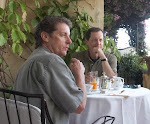
I first visited Pompeii in July 2004. As everyone knows, Pompeii is unique for the fact that Mother Nature (in the form of a volcano) both destroyed it and saved it, on the same day, for future generations to experience and study. It is now one of my favorite destinations in Italy, and I’ll return any time I’m in the Naples area. As this photo shows (click once on it to enlarge it), the “ruins” of Pompeii even today carry the ominous backdrop of Mount Vesuvius – still there, still active, still dangerous to that entire region. See it there, sleeping in the background?
If we could have visited Pompeii on August 23 in the year 79 A.D., it would have been a peaceful, almost luxurious experience. Trade and industry were thriving. People were busy and well paid. The empire was at peace, at last, with Emperor Titus having taken the throne in Rome only a month earlier to succeed his late father Vespasian. In Pompeii, hundreds of shops would have been open to business, with horse drawn carts crowding the streets, and local residents and travelers from afar mingling on the elevated sidewalks and in the markets and public parks. The biggest "issues" of the day were the upcoming city magistrate elections and the mysterious slow-down of water coming into the city from its main aqueduct. Why was that happening? Why would the water volume just drop off without any apparent cause?
In fact, no one at that time was aware that the large mountain not far from the city was a volcano. Yes, they knew what a volcano was. Mount Etna on Sicily had been active for many years to one degree or another, but everyone assumed Vesuvius was just a mountain.
Then, at lunchtime on August 24, everything changed … or ended … for the throngs in the streets, businesses and homes of this doomed city. This was an eruption like nothing modern man has ever seen. When it blew, it released the power equivalent of 100,000 Hiroshima atomic bombs exploding at once, lifting a third of the mountain into the sky (the column of molten magma and ash reaching a height of 20 miles "straight up"). The force spewed 1.5 million tons of molten material upward every second – at a velocity of "Mach 1" (the speed of sound). This is a level of natural violence our brains simply cannot accommodate. As the falling brimstone and ash began covering Pompeii, most people simply believed that time had come to an end and the force that holds the world together had died. Many fled the city, while others gathered their families and pets in an inner room of their home to “wait it out - - whatever it was.”
 [The photo at left is one of he many well-preserved casts of the individual victims of Vesuvius.] Then things got much, much worse. When the energy from the eruption finally ceased after about 20 hours, the molten column of material that had been forced into the stratosphere collapsed downward, spreading laterally when it hit the earth, and creating a super-heated tidal wave (600 degrees Fahrenheit) that vaporized any living thing in its path. Many of those who had escaped the city itself were mowed down by this final pyroclastic flow of magma and gas.
[The photo at left is one of he many well-preserved casts of the individual victims of Vesuvius.] Then things got much, much worse. When the energy from the eruption finally ceased after about 20 hours, the molten column of material that had been forced into the stratosphere collapsed downward, spreading laterally when it hit the earth, and creating a super-heated tidal wave (600 degrees Fahrenheit) that vaporized any living thing in its path. Many of those who had escaped the city itself were mowed down by this final pyroclastic flow of magma and gas.For centuries thereafter the city was simply written off as lost forever to history, like Troy. Then in 1748 diggers discovered it again and the government began sponsoring professional archaeologists to conduct proper excavation. Now in 2009, they are about two-thirds finished with the task.
What can you do if you go to visit Pompeii today? Take a tour, for sure, just to get your bearings and to understand some of the visual history present. Then break away from the crowds and wander the excavated Roman city on your own. Step into people’s homes; walk back to their kitchen areas; sit down by the family hearth and conjure up the normal, ever
 yday people who once called this little spot their home. Picture the housewife bracing herself in the front doorway, wondering why her husband, the local baker, has not yet made it home through the chaos in the streets. Where could he be? Has he been hurt by the falling fire stones? These people were as real as you or I, and they were the unwilling witnesses to history on a day in August that had begun so much like any other.
yday people who once called this little spot their home. Picture the housewife bracing herself in the front doorway, wondering why her husband, the local baker, has not yet made it home through the chaos in the streets. Where could he be? Has he been hurt by the falling fire stones? These people were as real as you or I, and they were the unwilling witnesses to history on a day in August that had begun so much like any other.








